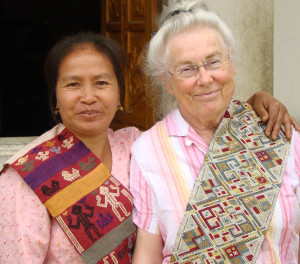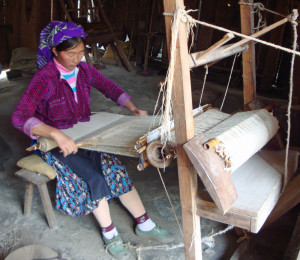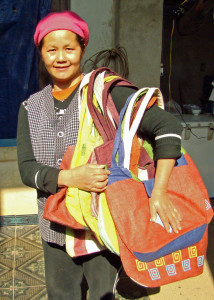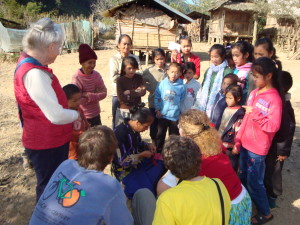Highlights from Grandma – Hemp Weavers of Vietnam by Joy Hirschstein (Mom and Grandma)
I was very excited to be able to join my son Joshua and his family on their latest venture to Laos and Vietnam. As a 79-year-old grandma, this “trip of a lifetime” seemed a bit intimidating before we started; my doctors loaded me with pills and dire warnings of tropical diseases and unusual diets. However, my worries were not warranted. The scenery was fantastic, the hilltribe weavers were warm and welcoming, the health hazards were greatly exaggerated, and the local food was fresh, tasty and healthy. The moderate winter climate (70o days, 55o evenings, and moist air) even dismissed my arthritis! We traveled about half the time in a comfortable van (although the axle did break on one particularly steep mountain turn), but I also had the chance to travel in local buses, airplanes, boats, and even on a motorcycle!
Age in Asia is certainly an asset; neither family nor locals allowed me to carry a thing other than my own purse! I was consistently honored for being so “healthy and beautiful”, and was even gifted with several beautiful scarves. The weavers of Xam Tai even presented me with a a special “Basi” ceremony and feast, with a local shaman blessing our family with long-life and good wishes. (Note: See Newsletter #3 at www.hilltribeart.com/events for information about Laos’ Basi ceremonies).
A most memorable visit was to the small Vietnamese village of Lung Tam, set in a rocky, rugged valley in Ha Giang Province, that produces hemp products. We saw the hemp stripped from the plant, spun, woven, bleached and drying in the sun in great sheets spread along the dirt streets and fields. The hemp was spun into thread on home-made spindles and then woven on simple wooden looms. These sheets were ironed flat by a woman standing on a large flat stone who rocked back and forth over the fabric that had been placed on a rounded stone. Watching Maren try her hand at ironing got the whole village doubled over in laughter! The village women then naturally-dye the hemp material and sew it into decorated wall-hangings and shoulder bags.
The woman who ran the shop explained to us, through Sho, our translator, that she hires women who have returned from being kidnapped and forced into the sex and child slave market that is prevalent in nearby southern China. Since the Chinese often favor boy children, there is a shortage of marriageable women available. Apparently, many young women in Ha Giang Province are kidnapped each year and married through an underground market in China. Many escape or, after having a girl child, are dismissed only to return to their homeland needing to support their child. (In one of Sho’s sister’s villages in Lai Chau Province, 6 young women were kidnapped on one evening -only 4 made their way back home.) Her business offers these women an apprenticeship to learn the hemp weaving trade, a home, and place to earn a decent living. Here, amid the beauty of the land and the pleasant simplicity of village life, we were shockingly reminded of the cruelty and selfishness of some humans and the grim challenges that remain hidden to much of our world.
The trip was very memorable. Not only was I welcomed by so many wonderful hilltribe people, but I also had the chance to spend some unique quality time (as in 24/7!) with my son, daughter-in-law, and 2 grandchildren. Even though I didn’t always have the energy to charge up to the top of the hill, I did feel that my age did not hold me back from enjoying the fantastic scenery and daily adventure, and was even an asset when it came to connecting with the local villagers who culturally revere their elders.




